2003 PONTIAC BONNEVILLE washer fluid
[x] Cancel search: washer fluidPage 260 of 418
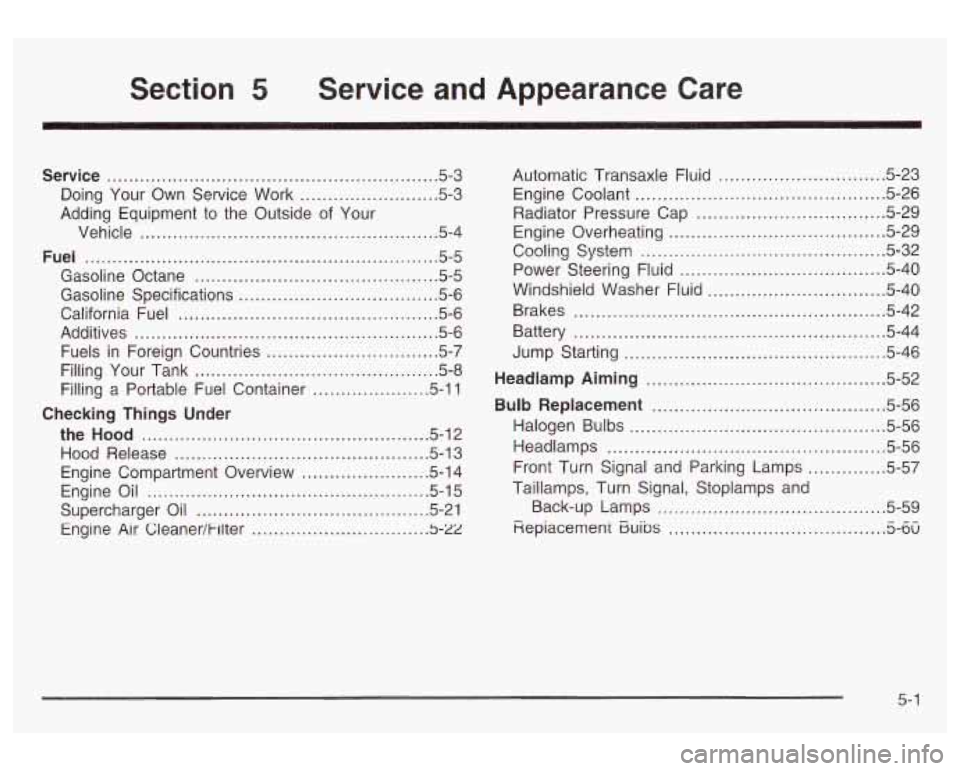
Section 5 Service and Appearance Care
Service ........................................................ 5.3
Doing Your Own Service Work
......................... 5.3
Adding Equipment to the Outside
of Your
Vehicle
...................................................... 5.4
Fuel ................................................................ 5.5
Gasoline Octane
............................................ 5.5
Gasoline Specifications
.................................... 5.6
California Fuel
............................................... 5.6
Additives
....................................................... 5.6
Fuels in Foreign Countries
............................ 5.7
Filling Your Tank
........................... .......... 5.8
Filling
a Portable Fuel Container ..... .... 5.11
the Hood ............................. .... 5.12
Hood Release
.............................. ........ 5.13
Engine Compartment Overview ...................... -5-1 4
Checking Things Under
Engine Oil ................................................... 5.15
Supercharger Oil .......................................... 5.21
Engine Air Cleaner/t-llter
................................ 5-22
Automatic Transaxle Fluid .............................. 5.23
Engine Coolant
............................................. 5.26
Radiator Pressure Cap
.................................. 5.29
Engine Overheating
....................................... 5.29
Cooling System
............................................ 5.32
Power Steering Fluid
..................................... 5.40
Windshield Washer Fluid
................................ 5.40
Brakes
........................................................ 5.42
Battery
........................................................ 5-44
Jump Starting
............................................... 5-46
Headlamp Aiming .......................... ...... 5.52
Bulb Replacement .................................. -5-56
Halogen Bulbs
.............................................. 5.56
Headlamps
.................................................. 5.56
Front Turn Signal and Parking Lamps
.............. 5-57
Taillamps, Turn Signal, Stoplamps and
Back-up Lamps
......................................... 5-59
fiepiacement
Euibs 3.w - ^^ .......................................
5- I
Page 271 of 418
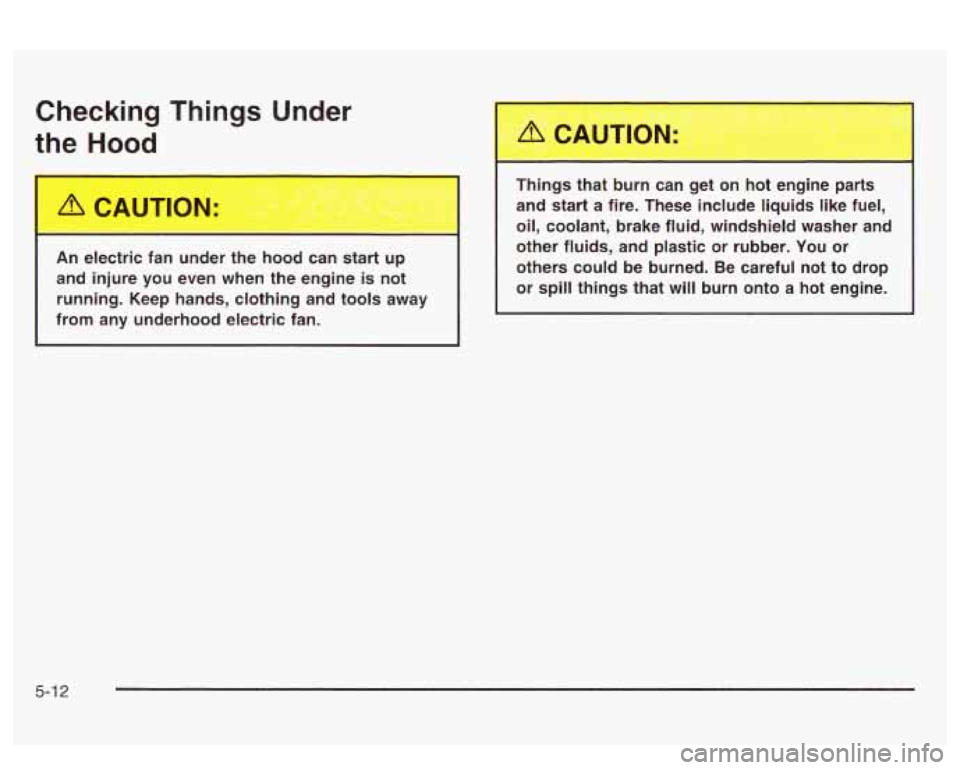
Checking Things Under
the Hood
I
An electric fan under the hood can start up
and injure you even when the engine
is not
running. Keep hands, clothing and tools away
from any underhood electric fan. Things that
b n can get on hot engine parts
and start a fire. These include liquids like fuel,
oil, coolant, brake fluid, windshield washer and
other fluids, and plastic or rubber. You or
others could be burned. Be careful not to drop
or
spill things that will burn onto a hot engine.
5-1 2
Page 274 of 418

A. Engine Compartment Fuse Block
B. Windshield Washer Fluid Reservoir
C. Engine Coolant Recovery Tank
D. Radiator Pressure Cap
E. Power Steering Fluid Reservoir
F. Engine Oil Dipstick
G. Engine Oil Fill Cap
H. Automatic Transaxle Fluid Dipstick
I. Brake Master Cylinder
J. Engine Air Cleaner/Filter
Engine Oil
WCHECK
OIL LEVEL
If the OIL LEVEL LOW
message appears
on the
DIC, or the CHECK
OIL LEVEL light appears
on the instrument cluster, it
means
YOU need to
check your engine oil level
right away.
For more information, see
Check Oil Level Light on
page
3-50 or DIG Warnings and Messages on
page 3-60.
You should check your engine oil level regularly; this is
an added reminder.
5-1 5
Page 299 of 418
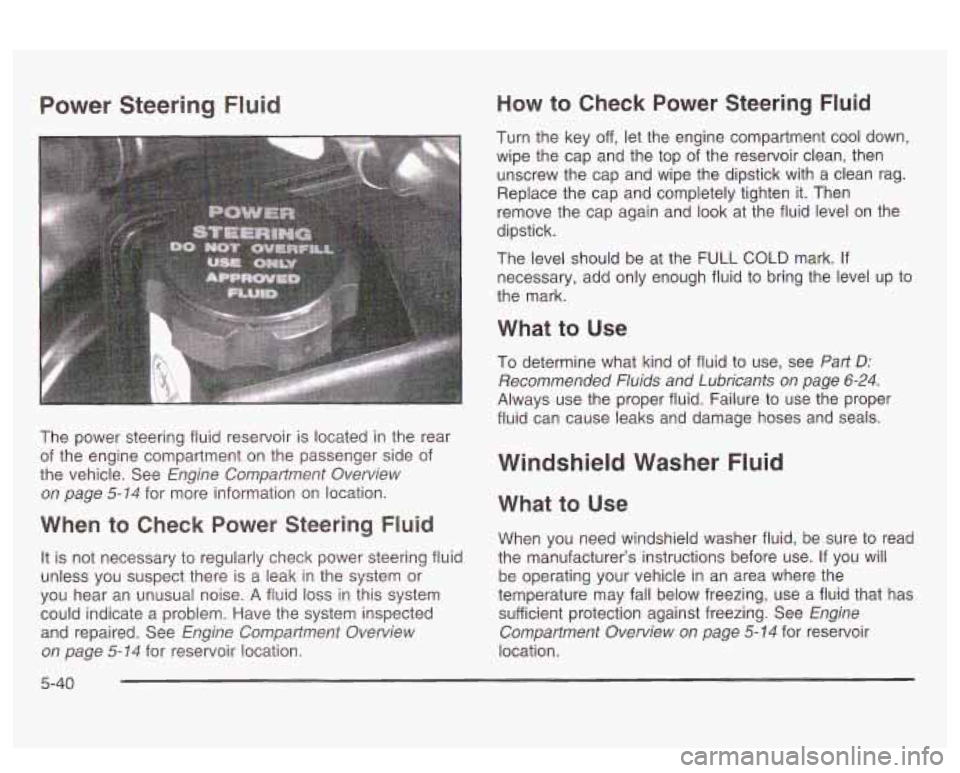
Power Steering Fluid
The power steering fluid reservoir is located in the rear
of the engine compartment on the passenger side of
the vehicle. See
Engine Compartment Overview
on page
5-74 for more information on location.
When to Check Power Steering Fluid
It is not necessary to regularly check power steering fluid
unless you suspect there is a leak in the system or
you hear an unusual noise. A fluid
loss in this system
could indicate a problem. Have the system inspected
and repaired. See
Engine Compartment Overview
on page
5- 74 for reservoir location.
How to Check Power Steering Fluid
Turn the key off, let the engine compartment cool down,
wipe the cap and the top of the reservoir clean, then
unscrew the cap and wipe the dipstick with a clean rag.
Replace the cap and completely tighten
it. Then
remove the cap again and look at the fluid level on the
dipstick.
The level should be at the
FULL COLD mark. If
necessary, add only enough fluid to bring the level up to
the mark.
What to Use
To determine what kind of fluid to use, see Part D:
Recommended Fluids and Lubricants on page 6-24.
Always use the proper fluid. Failure to use the proper
fluid can cause leaks and damage hoses and seals.
Windshield Washer Fluid
What to Use
When you need windshield washer fluid, be sure to read
the manufacturer’s instructions before use.
If you will
be operating your vehicle in an area where the
temperature may fall below freezing, use a fluid that has
sufficient protection against freezing. See
Engine
Compartment Overview on page
5-14 for reservoir
location.
5-40
Page 300 of 418
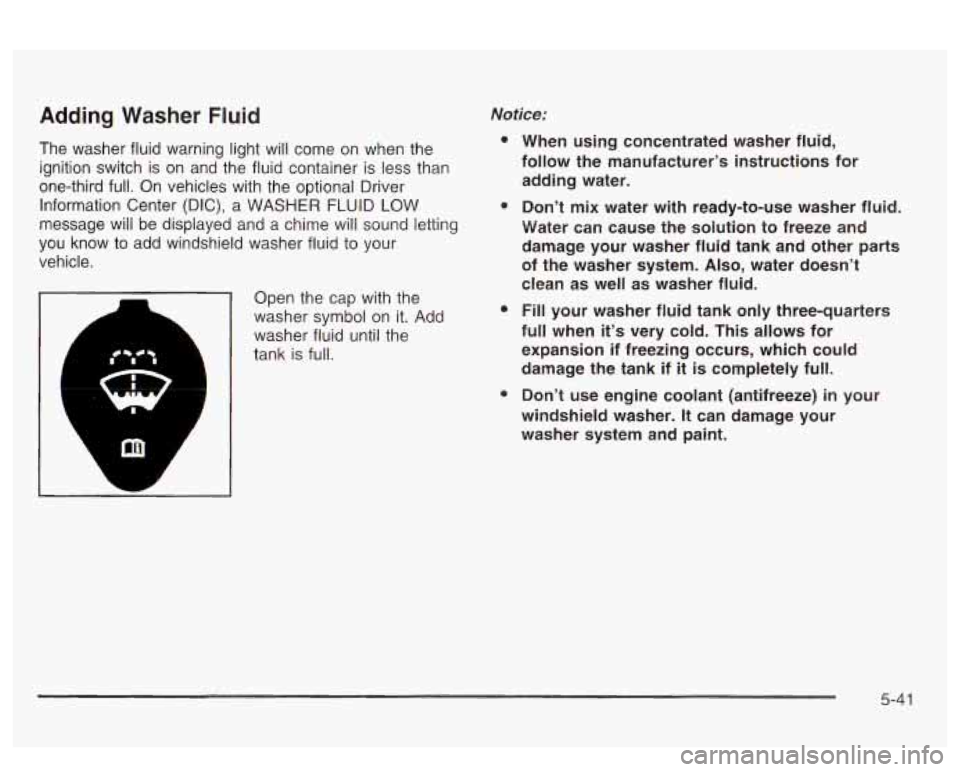
Adding Washer Fluid
The washer fluid warning light will come on when the
ignition switch is on and the fluid container is less than
one-third full. On vehicles with the optional Driver
Information Center (DIC), a WASHER FLUID LOW
message
will be displayed and a chime will sound letting
you know to add windshield washer fluid to your
vehicle.
Open the cap with the
washer symbol on it. Add
washer fluid until the
tank is full.
Notice:
e
e
e
0
When using concentrated washer fluid,
follow the manufacturer’s instructions for adding water.
Don’t mix water with ready-to-use washer fluid.
Water can cause the solution to freeze and
damage your washer fluid tank and other parts
of the washer system.
Also, water doesn’t
clean as well as washer fluid.
Fill your washer fluid tank only three-quarters
full when
it’s very cold. This allows for
expansion if freezing occurs, which could damage the tank if
it is completely full.
Don’t use engine coolant (antifreeze)
in your
windshield washer. It can damage your
washer system and paint.
5-4 1
Page 379 of 418
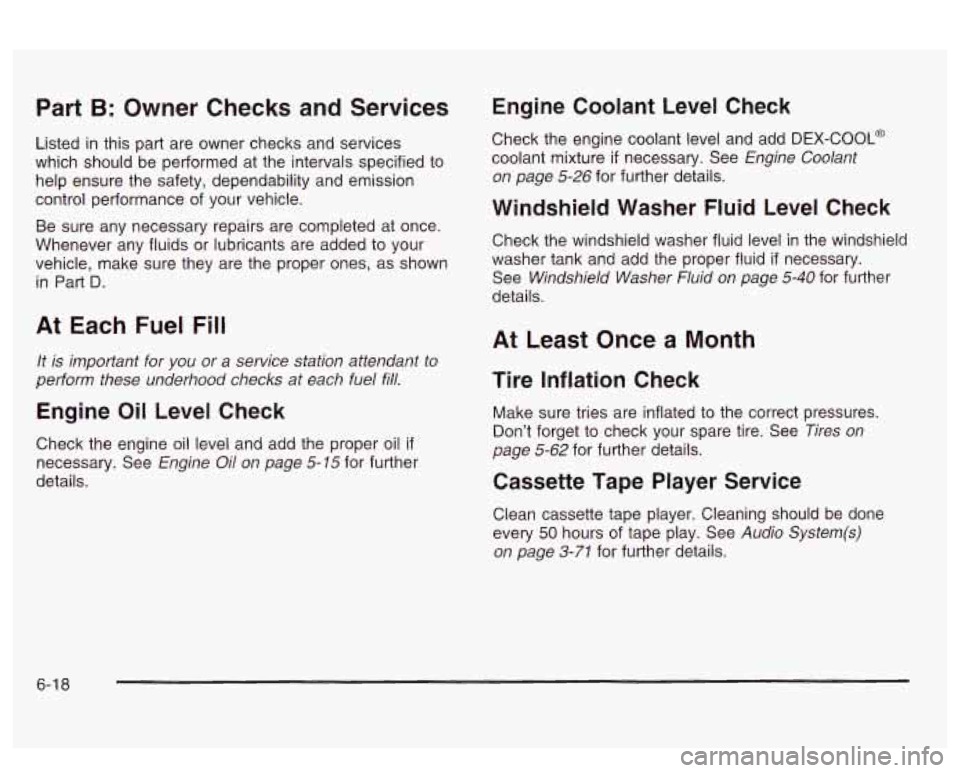
Part B: Owner Checks and Services
Listed in this part are owner checks and services
which should be perFormed at the intervals specified to
help ensure the safety, dependability and emission
control performance of your vehicle.
Be sure any necessary repairs are completed at once.
Whenever any fluids or lubricants are added to your
vehicle, make sure they are the proper ones, as shown
in Part D.
At Each Fuel Fill
It is important for you or a service station attendant to
perform these underhood checks at each fuel fill.
Engine Oil Level Check
Check the engine oil level and add the proper oil if
necessary. See Engine Oil on page 5-75 for further
details.
Engine Coolant Level Check
Check the engine coolant level and add DEX-COOL@
coolant mixture
if necessary. See Engine Coolant
on page 5-26
for further details.
Windshield Washer Fluid Level Check
Check the windshield washer fluid level in the windshield
washer tank and add the proper fluid
if necessary.
See
Windshield Washer Fluid on page 5-40 for further
details.
At Least Once a Month
Tire Inflation Check
Make sure tries are inflated to the correct pressures.
Don’t forget to check your spare tire. See
Tires on
page 5-62
for further details.
Cassette Tape Player Service
Clean cassette tape player. Cleaning should be done
every
50 hours of tape play. See Audio System(s)
on page
3-77 for further details.
6-1 8
Page 385 of 418
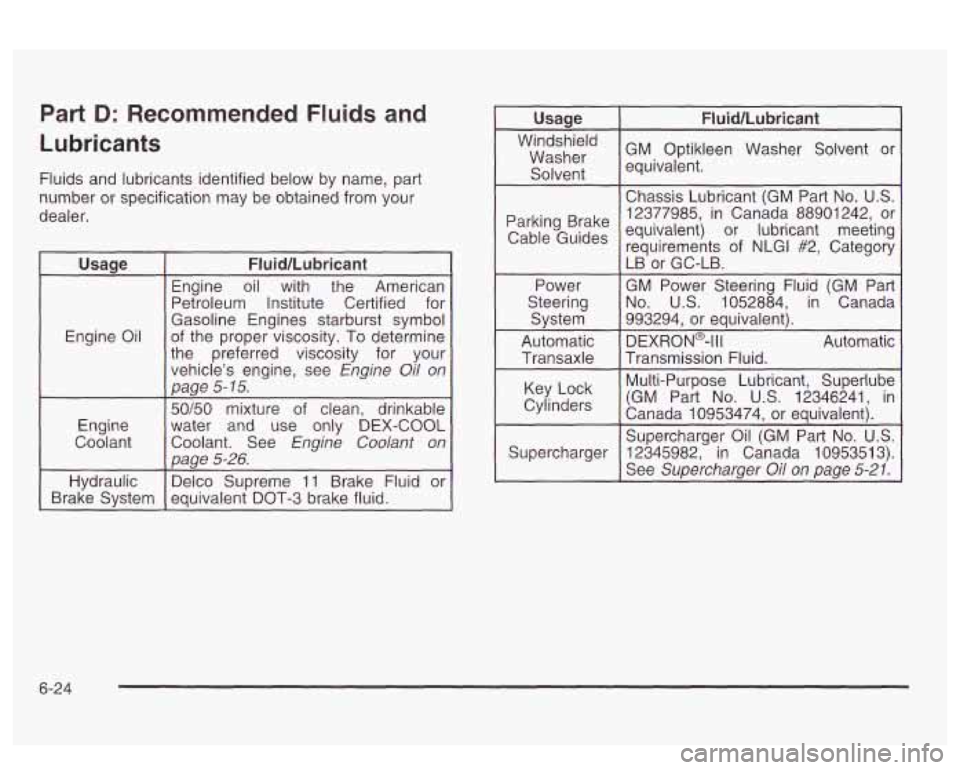
Part D: Recommended Fluids and
Lubricants
Fluids and lubricants identified below by name, part
number or specification may be obtained from your
dealer.
I Usaae I Fluid/Lubricant I
Engine Oil Engine
oil with the American
Petroleum Institute Certified for
Gasoline Engines starburst symbol
of the proper viscosity. To determine
the preferred viscosity for your
vehicle's engine, see
Engine Oil on
page
5- 75.
Engine
Coolant 50/50 mixture
of clean, drinkable
water and use only DEX-COOL
Coolant. See
Engine Coolant on
Daae
5-26. L ,"
Hydraulic Delco
Supreme 11 Brake Fluid or
Brake System equivalent DOT-3 brake fluid.
Usage I Fluid/Lubricant I
GM Optikleen Washer Solvent or Washer
Solvent equivalent.
Chassis Lubricant
(GM Part No.
US.
12377985, in Canada 88901242, or Parking Brake
Cab'e Guides equivalent) or lubricant meeting
requirements of NLGI #2, Category
Power GM Power Steering Fluid (GM Part
Steering No.
US. 1052884,
in Canada
System 993294, or
equivalent).
Automatic DEXRON@-Ill Automatic Transaxle Transmission Fluid. LB
or GC-LB.
Multi-Purpose Lubricant, Superlube
Key Lock
Canada 10953474, or equivalent). Cylinders (GM Part No. U.S. 12346241, in
Supercharger Oil (GM Part
No. U.S.
Supercharger
See Supercharger Oil on page 5-21.
12345982, in Canada 1095351 3).
6-24
Page 400 of 418

A
Accessory Inflator ........................................... 5-72
Accessory Power Outlets
................................. 3-23
Adding Washer Fluid
....................................... 5-41
Additional Program Information
........................... 7-7
Additives. Fuel
................................................. 5-6
Add-on Electrical Equipment
............................ 5-91
Adjusting the Speakers (Balance/Fade)
...... 3.75. 3-85
Air Bag
Readiness Light
.......................................... 3-40
Air Bag Systems
............................................. 1-47
How Does an Air Bag Restrain?
.................... 1-52
Servicing Your Air Bag-Equipped Vehicle
......... 1-55
What Makes an Air Bag Inflate? .................... 1-52
What Will You See After an Air Bag Inflates?
.. 1-53
When Should an Air Bag Inflate?
................... 1-51
Where
Are the Air Bags? .............................. 1-50
Air Cleaner/Filter, Engine
................................. 5-22
All Overseas Locations
...................................... 7-4
Aluminum or Chrome-Plated Wheels
.................. 5-86
Ar~ie~~~~a, ulversiiy a- IU I
Antenna, XM Satellite Radio System ................ 3-101
Anti-lock Brake System (ABS)
............................ 4-7
Anti-Lock Brake, System Warning Light
.............. 3-43
Appearance Care
............................................ 5-82
Care of Safety Belts
.................................... 5-85
Chemicai Paint Spotting
............................... 5-88
AM ............................................................... 3-99 R . 0 an* .........................................
Appearance Care (cont.)
Cleaning the Inside of Your Vehicle
................ 5-82
Cleaning the Outside of Your Vehicle
.............. 5-85
Finish Damage
............................................ 5-87
GM Vehicle Care/Appearance Materials
.......... 5-88
Sheet Metal Damage
................................... 5-87
Underbody Maintenance
............................... 5-87
Weatherstrips
.............................................. 5-85
Ashtrays
........................................................ 3-24
Audio System(s)
............................................. 3-71
Audio Systems
Audio Steering Wheel Controls
...................... 3-98
Care of Your Cassette Tape Player
............... 3-100
Care of Your CD Player
.............................. 3-101
Care of Your CDs
...................................... 3-100
Chime Levei Adjustment
............................. 3-101
Diversity Antenna System
............................ 3-1 01
Radio with Cassette and CD
......................... 3-82
Radio with CD
............................................ 3-72
Setting the Time
.......................................... 3-71
Theft-Deterrent Feature
................................ 3-98
Trunk-Mounted CD Chanuer
.......................... 3-94
Understanding Radio Reception
..................... 3-99
XM Satellite Radio Antenna System
.............. 3-101
Automatic Climate Control System
..................... 3-28
Automatic Door Locks
..................................... 3-64
Automatic Level Control
................................... 4-36
Automatic Operation
.................................... 3-28
1